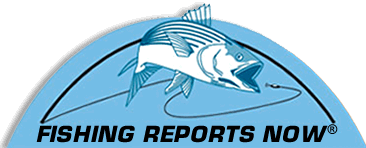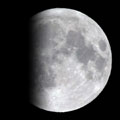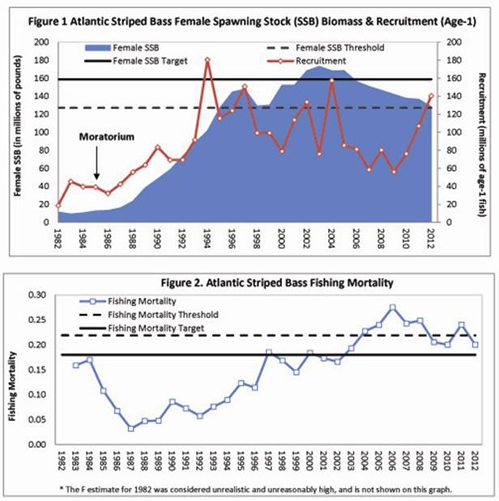But Spawning Biomass Declining
From the Atlantic States Marine Fisheries Commission:
FOR IMMEDIATE RELEASE, OCTOBER 31, 2013
Atlantic Striped Bass Benchmark Assessment
Finds Resource Not Overfished,
And Overfishing Not Occurring
Board Initiates Draft Addenda
To Adopt New Reference Points
And Considers Management Measures
To Address Declines in Spawning Stock Biomass
St. Simons Island, Georgia – The 2013 Atlantic striped bass benchmark assessment indicates the resource is not overfished or experiencing overfishing relative to the proposed new reference points defined in the assessment.
Although the stock is not overfished, female spawning stock biomass (SSB) has continued to decline since 2004 and is estimated at 128 million pounds just above the SSB threshold of 127 million pounds, and below the SSB target of 159 million pounds.
Additionally, total fishing mortality is estimated at 0.20, a value that is between the proposed new fishing mortality threshold (0.219) and fishing mortality target (0.18).
The Atlantic Striped Bass Management Board approved the benchmark stock assessment for management use.
Projections of female SSB and fishing mortality suggest if the current fishing mortality rate (0.20) is maintained during 2013-2017, the probability of the stock being overfished (SSB less than the SSB threshold) is high and increases until 2015-2016, but declines thereafter.
This trend is driven by the lack of strong year classes currently in the fishery, and the emergence of the strong 2011 year class that matures into the spawning stock in three to four years.
Despite recent declines in SSB, the stock is still well above the SSB during the moratorium that was in place in the mid-1980s (see Figure 1).
Given these findings and the management plan’s triggers (e.g., both fishing mortality and SSB are between their respective target and threshold limits), the Management Board initiated the development of two draft addenda.
The first addendum will propose adoption of the new fishing mortality reference points recommended by the benchmark assessment. These include fishing mortality reference points for the coastal stock as described above, as well as stock-specific reference points for the Chesapeake Bay and Albemarle/Roanoke stocks that will be developed by the Technical Committee.
The second addendum will propose a range of commercial and recreational management measures for the coastal, Chesapeake Bay, and Albemarle/Roanoke stocks to reduce fishing mortality to at least the target with a proposed implementation date of January 2015.
The Board intends to consider approval of the first draft addendum for public comment in February at the Commission’s Winter Meeting, and consider approval of the second draft addendum for public comment in May at the Commission’s Spring Meeting.
A more detailed description of the stock assessment results is available on the Commission’s website at http://www.asmfc.org/uploads/file/AtlStripedBassStockAssessmentOverview_Oct2013.pdf
The 2013 Atlantic Striped Bass Benchmark Stock Assessment and Peer Review is still being finalized by the Northeast Regional Stock Assessment Workshop/Stock Assessment Committee; please check http://www.nefsc.noaa.gov/saw/reports.html for its availability.
The Commission’s 2013 Stock Assessment Update, which revises the benchmark stock assessment with final 2012 landings, is available at http://www.asmfc.org/uploads/file/AtlStripedBass2013AssessmentUpdate.pdf
For more information, please contact Mike Waine, Fishery Management Plan Coordinator, at 703.842.0741 or mwaine@asmfc.org.
###
Tina Berger
Director of Communications
Atlantic States Marine Fisheries Commission
1050 N. Highland Street, Suite 200 A-N
Arlington, VA 22201
703.842.0740
www.asmfc.org






